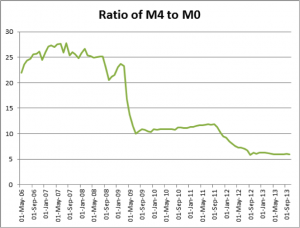I’ve recently written for Save Our Savers attempting to square the massive expansion of Britain’s monetary base since March 2009 with the fact that inflation has now been within the Bank of England’s target range of 2% (+/- 1%) since June 2012. Here I’d like to expand a little.
Since March 2009 Britain’s monetary base, also known as narrow money or M0, has increased by 321%. We can see that the majority of this is in the form of increased bank reserves, up 642% since March 2009

This is just what we’d expect to see following the Bank of England’s Quantitative Easing, where the Bank creates new money and uses it to purchase bonds from banks – that new money becomes bank reserves. Those banks have sat on that money (not using it as a basis for new credit creation and feeding into M4) which is why, while narrow (M0) money has exploded, broad (M4) money has barely budged, increasing by just 7.4% since March 2009.

This relative restraint in M4 growth explains the relative restraint in inflation. There is no great mystery as to why banks which have just seen their assets tank and ravage their balance sheets should want to hold more reserves. The key question is what happens next.
The chart above shows the ratio of M0 to M4 since May 2006; how many pounds of broad money each pound of narrow money is supporting. From 25:1 between May 2006 and March 2009, it slumped via successive bouts of Quantitative Easing to about 6:1 since September 2012.
Now, on the one hand banks might stick to this new, lower ratio. Chastened by their experiences with mortgage backed assets they might desire a permanently lower reserve to asset ratio and all QE will have been is a vast recapitalisation of banks.
On the other hand, as ‘recovery’ kicks in they might start to increase their reserve to asset ratio. They might not scale the giddy heights of 25:1 again, but they will be multiplying out from a monetary base which has tripled in size. Britain’s monetary base is now £362 billion and M4 is about six times that, £2.2 trillion. But if renewed confidence in the banking sector saw banks return to higher ratios, the resulting M4 figures would be as follows:
Here, we are told, the Bank of England will be able to ‘drain’ this liquidity from the system. It would do this by reversing QE; selling bonds to banks and effectively destroying the base money it receives in return. But a massive increase in the supply of bonds relative to the demand for them will lower their price. This is the same as raising their yield and this is the same as raising a key interest rate.
It is worth pondering for a moment the scale of bond sales and consequent rise in interest rates which might be necessary to drain this base money from the financial system. We must hope either that the economy can stand it or that banks keep holding these reserves.



Monetary base up by about 320% since 2009 – broad money (bank credit) up by about 7% since 2009.
So it is clear that monetary policy was not just about saving the zombie banks in 2008 – monetary policy since then has been about saving the zombie financial system (the banks and so on) also.
And if the banks did what the politicians say they want and started “lending again” (i.e. constructing a pyramid of debt upon the increase in the monetary base)? Well then there would be a vast inflation – and another boom-bust (on a vastly bigger scale than in 2008).
The zombie banks have done the least worst thing with the increase in the monetary base – “sit on it”. They have increased their reserves by more than 6 times (more than 600%) and live by borrowing money from the Bank of England (money it creates from nothing) and lending it back (at a higher interest rate) to the government to fund the deficit.
Of course, eventually the zombie banks will fall (there are plenty of things to come that will destroy them) and take the zombie financial system with them. But government Bank of England policy has delayed the collapse – and for understandable reasons.
No one wants things to fall apart on their watch.
As the phoney recovery takes place and the banks start to leverage in order to lend,which they will, the Bank of England will not be able to reverse QE for risk of crippling the banks again.
They have no way out of the pickle and they are beginning to realise it.
Much the same as Bernenke will not be allowed to conduct a meaningful taper(not least by GS)because of the vast malinvestment now dormant in the economy, the BofE will be unable to either reverse QE or raise intereest rates without causing mayhem in the economy
Just wanted to point out that the chopper wizard has grounded himself after tomorrow and the new pilot for QE airlines starting 2/1/2014 will be Janet Yellen.
One of the factor behind banks “sitting” on the money, is the fact that many of them are locked into loans by long dated high interest fixed rate swaps that in some cases, go out for another 20 years. In a low interest rate environment, this generates a high cost to exiting the swap early, thus preventing the bank from calling the loan. This is aside from the fact that the value of many of these loans may be greater than the value of the collateral, necessitating a larger reserve. In such a case, high reserves are necessary to meet ongoing and elevated liquidity demands.